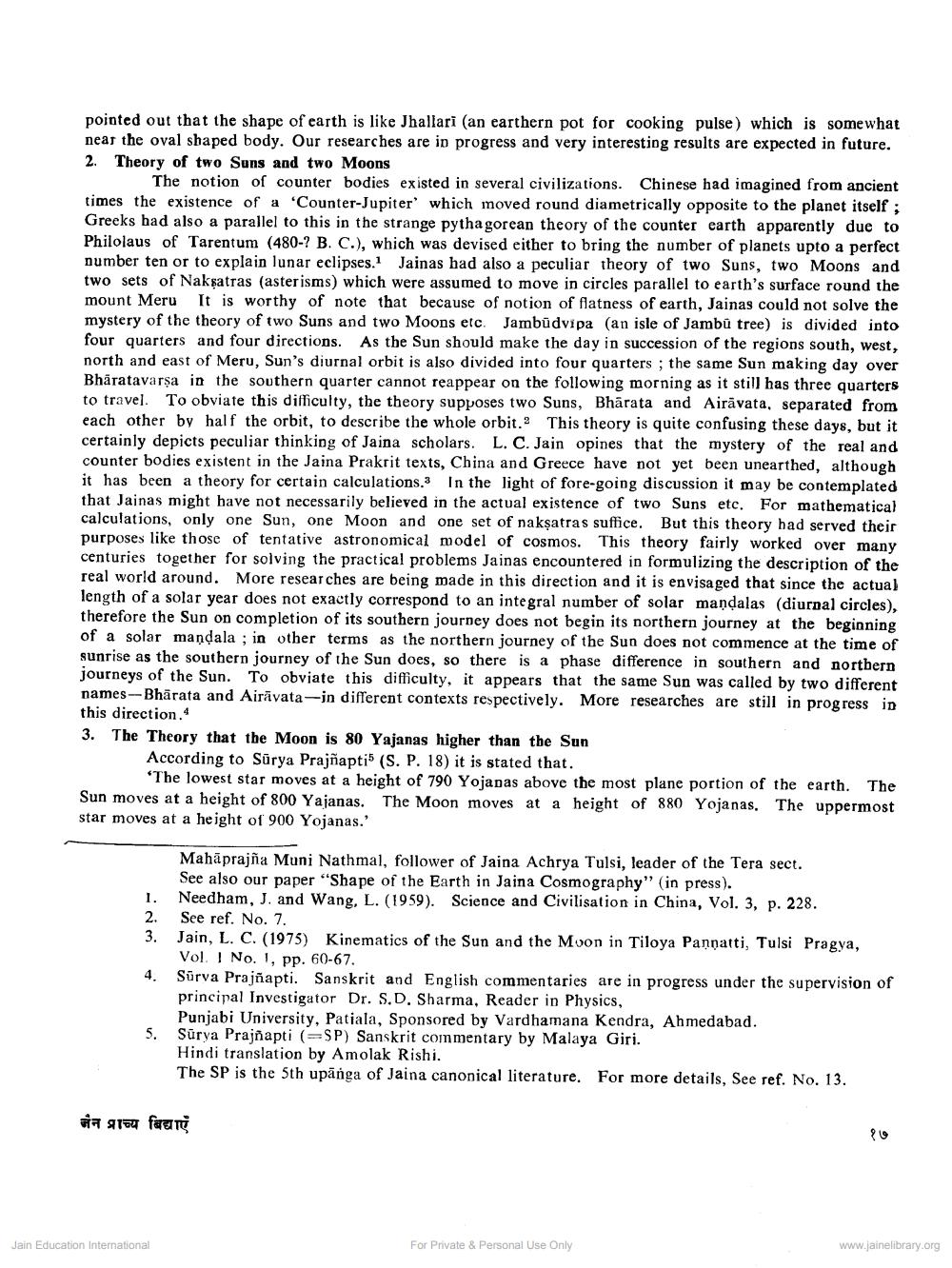________________
pointed out that the shape of earth is like Jhallari (an earthern pot for cooking pulse) which is somewhat near the oval shaped body. Our researches are in progress and very interesting results are expected in future. 2. Theory of two Suns and two Moons
The notion of counter bodies existed in several civilizations.
Chinese had imagined from ancient times the existence of a 'Counter-Jupiter' which moved round diametrically opposite to the planet itself; Greeks had also a parallel to this in the strange pythagorean theory of the counter earth apparently due to Philolaus of Tarentum (480-? B. C.), which was devised either to bring the number of planets upto a perfect number ten or to explain lunar eclipses.1 Jainas had also a peculiar theory of two Suns, two Moons and two sets of Nakṣatras (asterisms) which were assumed to move in circles parallel to earth's surface round the mount Meru It is worthy of note that because of notion of flatness of earth, Jainas could not solve the mystery of the theory of two Suns and two Moons etc. Jambudvipa (an isle of Jambu tree) is divided into four quarters and four directions. As the Sun should make the day in succession of the regions south, west, north and east of Meru, Sun's diurnal orbit is also divided into four quarters; the same Sun making day over Bharatavarṣa in the southern quarter cannot reappear on the following morning as it still has three quarters to travel. To obviate this difficulty, the theory supposes two Suns, Bharata and Airavata, separated from each other by half the orbit, to describe the whole orbit. This theory is quite confusing these days, but it certainly depicts peculiar thinking of Jaina scholars. L. C. Jain opines that the mystery of the real and counter bodies existent in the Jaina Prakrit texts, China and Greece have not yet been unearthed, although it has been a theory for certain calculations. In the light of fore-going discussion it may be contemplated that Jainas might have not necessarily believed in the actual existence of two Suns etc. For mathematical calculations, only one Sun, one Moon and one set of nakṣatras suffice. But this theory had served their purposes like those of tentative astronomical model of cosmos. This theory fairly worked over many centuries together for solving the practical problems Jainas encountered in formulizing the description of the real world around. More researches are being made in this direction and it is envisaged that since the actual length of a solar year does not exactly correspond to an integral number of solar mandalas (diurnal circles), therefore the Sun on completion of its southern journey does not begin its northern journey at the beginning of a solar mandala ; in other terms as the northern journey of the Sun does not commence at the time of sunrise as the southern journey of the Sun does, so there is a phase difference in southern and northern journeys of the Sun. To obviate this difficulty, it appears that the same Sun was called by two different names-Bharata and Airavata-in different contexts respectively. More researches are still in progress in this direction.4
3. The Theory that the Moon is 80 Yajanas higher than the Sun
According to Surya Prajñaptis (S. P. 18) it is stated that.
'The lowest star moves at a height of 790 Yojanas above the most plane portion of the earth. The Sun moves at a height of 800 Yajanas. The Moon moves at a height of 880 Yojanas. The uppermost star moves at a height of 900 Yojanas.'
1.
2.
3. Jain, L. C. (1975) Kinematics of the Sun and the Moon in Tiloya Pannatti, Tulsi Pragya,
Vol. I No. 1, pp. 60-67.
Sūrva Prajñapti. Sanskrit and English commentaries are in progress under the supervision of principal Investigator Dr. S.D. Sharma, Reader in Physics,
4.
Mahaprajña Muni Nathmal, follower of Jaina Achrya Tulsi, leader of the Tera sect. See also our paper "Shape of the Earth in Jaina Cosmography" (in press). Needham, J. and Wang, L. (1959). Science and Civilisation in China, Vol. 3, p. 228. See ref. No. 7.
Punjabi University, Patiala, Sponsored by Vardhamana Kendra, Ahmedabad.
5. Surya Prajñapti (SP) Sanskrit commentary by Malaya Giri.
Jain Education International
Hindi translation by Amolak Rishi.
The SP is the 5th upanga of Jaina canonical literature. For more details, See ref. No. 13.
जंन प्राच्य बिद्याएं
For Private & Personal Use Only
१७
www.jainelibrary.org




